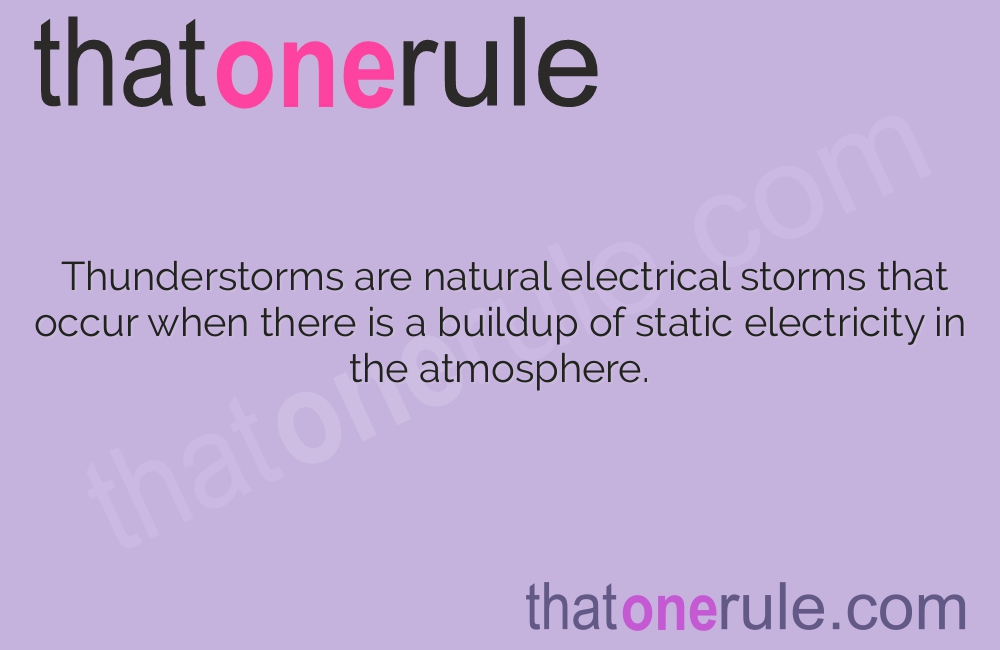Fascinating Facts about Thunderstorms

Thunderstorms are natural electrical storms that occur when there is a buildup of static electricity in the atmosphere.
Thunderstorms can occur anywhere in the world, but are most common in tropical regions.
The average thunderstorm can last between 30 minutes to an hour.
Thunderstorms are usually accompanied by heavy rain, strong winds, and lightning.
The sound of thunder is caused by the rapid expansion and contraction of air surrounding a lightning bolt.
Thunderstorms are more likely to occur during the warm summer months.
Lightning strikes the Earth about 100 times every second.
The temperature inside a thunderstorm can reach up to 50,000 degrees Fahrenheit.
Thunderstorms can cause flash floods, which can be extremely dangerous.
Thunderstorms are more likely to occur in the late afternoon or evening.
Thunderstorms can create hail, which is formed when supercooled water droplets freeze in the storm’s updrafts.
Thunderstorms can produce strong downdrafts called microbursts, which can cause sudden and drastic changes in wind direction.
Lightning can strike the same place multiple times during a thunderstorm.
Thunderstorms play a crucial role in balancing the Earth’s temperature and redistributing heat.
Thunderstorms can produce tornadoes, which are rapidly rotating columns of air.
Florida is known as the lightning capital of the United States due to its high frequency of thunderstorms.
Fascinating Facts about Thunderstorms part 2
Thunder can often be heard up to 10 miles away from the location of a lightning strike.
Thunderstorms can cause power outages by damaging power lines with strong winds or lightning strikes.
Thunderstorms are more likely to occur in mountainous areas due to the uplift of moist air when it encounters the terrain.
Thunderstorms can help purify the air by releasing ozone, which helps to remove pollutants.
Lightning from thunderstorms can strike planes in flight, but it rarely causes serious damage.
The largest thunderstorm on record, known as a mesoscale convective system, covered an area of 150,000 square miles.
Atmospheric pressure drops before a thunderstorm, which can sometimes cause people to experience headaches or migraines.
Thunderstorms can produce captivating displays of colors in the sky, known as lightning sprites or jellyfish lightning.
Thunderstorms are more likely to occur in areas with high humidity and unstable atmospheric conditions.
Thunderstorms can disrupt radio signals and interfere with television reception.
Thunder is the sound caused by the rapid expansion and contraction of the air surrounding a lightning bolt.
Thunderstorms can trigger landslides and mudslides in areas with steep slopes.
The average thunderstorm contains about one billion volts of electricity.
Thunderstorms are often accompanied by a distinct smell known as petrichor, which is the scent released by damp soil after rain.
Thunderstorms can create a phenomenon called a supercell, which is a highly organized thunderstorm with rotating updrafts.
Thunderstorms can generate strong updrafts that can carry water droplets into the upper levels of the atmosphere, forming thunderstorm anvils.
Thunder is not actually caused by lightning, but by the rapid expansion and contraction of the air surrounding a lightning bolt.
Thunderstorms occur nearly 16 million times worldwide each year.
Thunderstorm clouds, known as cumulonimbus clouds, can reach heights of 10 to 15 kilometers.
Thunderstorms can produce positive lightning, which is more dangerous and less common than the negatively charged lightning.
Thunderstorms are more likely to occur in areas with a lot of open space, as this allows for the buildup of electrical charge.
Thunderstorms can create a phenomenon called St. Elmo’s fire, which is a luminous glow that occurs around objects during a thunderstorm.
Thunderstorms can create gust fronts, which are cool, sinking air masses that move ahead of a storm.
Thunderstorms have been a subject of fascination for centuries and have inspired many works of art, literature, and music.
Thunderstorms can produce downbursts, which are intense columns of air that sink rapidly to the ground, causing widespread damage.
Thunderstorms have variable lifetimes, with some lasting only a few minutes while others can persist for several hours.
Thunderstorms can create a phenomenon called ball lightning, which is a rare and unexplained phenomenon where a glowing ball of light appears during a storm.
Thunderstorms generate a large amount of static electricity, which can sometimes be felt as a tingling sensation in the air.
Thunderstorms are a powerful reminder of the forces of nature and the awe-inspiring beauty of the natural world.